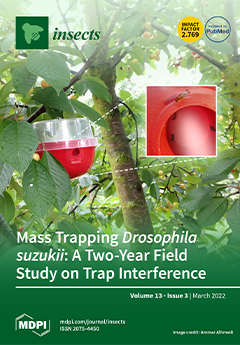Haplothrips niger is recognized as a parthenogenetic form of
H. leucanthemi and is also considered to be a pest in clover-seed plantations. On the contrary, some researchers highlight the distinctiveness of
H. niger and
H. leucanthemi. Taking into account these two points
[...] Read more.
Haplothrips niger is recognized as a parthenogenetic form of
H. leucanthemi and is also considered to be a pest in clover-seed plantations. On the contrary, some researchers highlight the distinctiveness of
H. niger and
H. leucanthemi. Taking into account these two points of view, as well as the lack of molecular studies investigating the relationship between the mentioned thrips, we decided to perform analyses of both mitochondrial (COI) and nuclear markers (28S and ITS2) to determine the genetic diversity of
H. leucanthemi and
H. niger. Additionally, as a part of an integrative approach, we determined and analyzed their microbiota profiles, based on high-throughput 16S rRNA gene sequencing. The results of the molecular analyses revealed high intraspecific diversity of
H. leucanthemi and did not support the distinctiveness of
H. niger. The identified microbiota profiles were similar in both species and the performed analyses also did not support the distinctiveness of
H. niger. Significant differences were, in turn, observed between
H. leucanthemi and
H. niger larvae. Moreover, two known endosymbiotic bacteria were found in the analyzed microbiota profiles (i.e.,
Wolbachia and
Rickettsia). Nevertheless, these symbionts were not predominantly found in the bacterial communities that are associated with
H. niger and thus, its impact on the parthenogenetic mode of its reproduction seems less likely.
Full article






